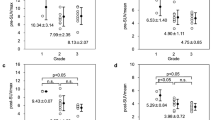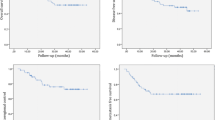Abstract
Purpose
Carbon ion radiotherapy (CIRT) has been developed, and a phase I/II CIRT trial has been conducted in patients with adenocarcinoma in the head and neck region. We evaluated whether the l-methyl [11C]-methionine (MET) uptake could be an early predictor for local recurrence, metastasis, and the prognosis in patients with adenocarcinoma in the head and neck region.
Methods
Twenty-six patients were prospectively studied by MET-positron emission tomography (PET) before and about 1 month after CIRT. The tumor MET uptake was measured with the semiquantitative tumor to normal tissue ratio (TNR). The tumor TNR and relevant clinical parameters were then evaluated by both univariate and multivariate analyses.
Results
The average TNRs before and after the treatment were 6.2 (±2.2) and 3.9 (±1.7), respectively, and significant differences were observed between them. In a univariate analysis, both local recurrence and metastasis were observed more frequently in the group with a higher TNR before and after the treatment than a lower TNR, and the prognosis was also poor. The cut-off values were 9.3, 4.9, and 5.1 before the treatment and 4.9, 4.2, and 4.3 after the treatment, respectively. In the rate of TNR changes before and after the treatment, metastasis was observed more frequently in the group with lower rates of change, and the prognosis was poor. The cut-off values for metastasis and prognosis determination were 18.0% and 16.9%, respectively. In a multivariate analysis, significant differences were observed for all relationships except for the relationship between the TNR before the treatment and local recurrence. Significant differences were observed for metastasis and prognosis in the rate of TNR changes before and after the treatment.
Conclusions
The determination of treatment effectiveness using TNR in CIRT for head and neck adenocarcinoma is an independent factor for predicting local recurrence, the incidence of metastasis, and the prognosis. MET-PET is therefore considered to be useful for determining the treatment effectiveness in patients with head and neck adenocarcinoma undergoing CIRT.


Similar content being viewed by others
References
Licitra L, Locati LD, Bossi P, Cantù G (2004) Head and neck tumors other than squamous cell carcinoma. Curr Opin Oncol 16:236–241
Teshima T, Inoue T, Inoue T et al (1993) Radiation therapy for carcinoma of the major salivary glands. Results of conventional irradiation technique. Strahlenther Oncol 169:486–491
Laramore GE, Krall JM, Griffin TW et al (1993) Neutron versus photon irradiation for unresectable salivary gland tumors: final report of an RTOG-MRC randomized clinical trial. Radiation Therapy Oncology Group. Medical Research Council. Int J Radiat Oncol Biol Phys 27:235–240
Tsukuda M, Kokatsu T, Ito K, Mochimatsu I, Kubota A, Sawaki S (1993) Chemotherapy for recurrent adeno- and adenoidcystic carcinomas in the head and neck. J Cancer Res Clin Oncol 119:756–758
Tsujii H, Mizoe J, Kamada T et al (2007) Clinical results of carbon ion radiotherapy at NIRS. J Radiat Res 48 (Suppl A):S1–A13
Zhang H, Yoshikawa K, Tamura K et al (2004) [11C] Methionine positron emission Tomography and survival in patients with bone and soft tissue sarcoma treated by carbon ion radiotherapy. Clin Cancer Res 10:1764–1772
Zhang H, Yoshikawa K, Tamura K et al (2004) Carbon-11-methionine positron emission tomography imaging of chordoma. Skeletal Radiol 33:524–530
Koizumi M, Saga T, Yoshikawa K et al (2008) 11C-methionine-PET for evaluation of carbon ion radiotherapy in patients with pelvic recurrence of rectal cancer. Mol Imaging Biol 10:374–380
Tamura K, Yoshikawa K, Ishikawa H et al (2009) Carbon-11-methionine PET imaging of choroidal melanoma and the time course after carbon ion beam radiotherapy. Anticancer Res 29:1507–1514
Blakely EA (1992) Cell inactivation by heavy charged particles. Radiat Environ Biophys 31:181–196
Tobias CA, Blakely EA, Alpen EL et al (1982) Molecular and cellular radiobiology of heavy ions. Int J Radiat Oncol Biol Phys 8:2109–2120
Ando K, Koike S, Ohira C et al (1999) Accelerated reoxygenation of a murine fibrosarcoma after carbon-ion radiation. Int J Radiat Biol 75:505–512
Hoffman RM (1984) Altered methionine metabolism, DNA methylation and oncogene expression in carcinogenesis. A review and synthesis. Biochim Biophys Acta 738:49–87
Hoffman RM (1990) Unbalanced transmethylation and the perturbation of the differentiated state leading to cancer. Bioassays 12:163–166
Stern PH, Hoffman RM (1984) Elevated overall rates of transmethylation in cell lines from diverse human tumors. In Vitro 20:663–670
Stern PH, Wallace CD, Hoffman RM (1984) Altered methionine metabolism occurs in all members of a set of diverse human tumor cell lines. J Cell Physiol 119:29–34
Wheatley DN (1982) On the problem of linear incorporation of amino acids into cell protein. Experientia 35:818–820
Kanai T, Endo M, Minohara S et al (1999) Biophysical characteristics of HIMAC clinical irradiation system for heavy ion radiation therapy. Int J Radiat Oncol Biol Phys 44:201–210
Langstrom B, Antoni G, Gullberg P et al (1987) Synthesis of L-and D-[methy-11C] methionine. J Nucl Med 28:1037–1040
Landau S, Rabe-Hesketh S (1999) StatView for Windows, Version 5.0. Stat Methods Med Res 8:337–341
Kato T, Shinoda J, Nakayama N et al (2008) Metabolic assessment of gliomas using 11C-methionine, 18F-FDG, and 11C-choline positron-emission tomography. AJNR 29:1432–1437
Lindholm P, Leskinen-Kallio S, Grenman R et al (1995) Evaluation of response to radiotherapy in head and neck cancer by positron emission tomography and [11C] methionine. Int J Radiat Oncol Biol Phys 32:787–779
Chesnay E, Babin E, Constans JM et al (2003) Early response to chemotherapy in hypopharyngeal cancer: assessment with (11) C-methionine PET, correlation with morphologic response, and clinical outcome. J Nucl Med 44:526–532
Bergstrom M, Muhr C, Lundberg PO (1991) PET as a tool in the clinical evaluation of pituitary adenomas. J Nucl Med 32:610–615
Jansson T, Westlin JE, Ahlstrom H, Lilja A, Langstrom B, Bergh J (1995) Positron emission tomography studies in patients with locally advanced and/or metastatic breast cancer, a method for early therapy evaluation? J Clin Oncol 13:1470–1477
Tsuyuguchi N, Hakuba A, Okamura T, Ochi H, Suzuki T, Sunada I (1997) PET for diagnosis of malignant lymphoma of the scalp: comparison of [11C]methyl-L-methionine and [18F]fluoro-2-deoxyglucose. J Comput Assist Tomography 21:590–593
Sato K, Kameyama M, Koyama T (1995) Serial positron emission tomography imaging of changes in amino acid metabolism in low grade astrocytoma after radio- and chemotherapy—case report. Neurol Med Chir 35:808–812
Acknowledgments
Thanks are due to Kanichi Seto, Ph.D., and Yoshiki Hamada, Ph.D., at First Department of Oral and Maxillofacial Surgery, Tsurumi University School of Dental Medicine, for constant support and encouragement. We are indebted to attending staff, at First Department of Oral and Maxillofacial Surgery, Tsurumi University School of Dental Medicine, for constant support. We are also indebted to Hiroyuki Ishikawa, D.D.S., and Katsumi Tamura, Ph.D., and Kenji Sago, D.D.S., and staff of PET diagnosis section, at NIRS for constant support. This study was supported by the research project with heavy ions at the National Institute of Radiological Sciences-Heavy Ion Medical Accelerator in Chiba. Part of this study was presented at the 54th Annual Meeting of the Society of Nuclear Medicine in June 2007.
Disclaimer
None.
Author information
Authors and Affiliations
Corresponding author
Rights and permissions
About this article
Cite this article
Hasebe, M., Yoshikawa, K., Ohashi, S. et al. A Study on the Prognostic Evaluation of Carbon Ion Radiotherapy for Head and Neck Adenocarcinoma with C-11 Methionine PET. Mol Imaging Biol 12, 554–562 (2010). https://doi.org/10.1007/s11307-010-0318-9
Published:
Issue Date:
DOI: https://doi.org/10.1007/s11307-010-0318-9




